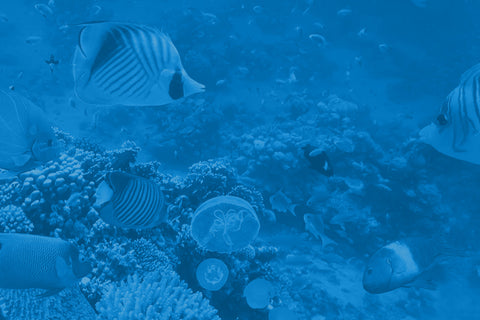
Flashy news articles alert! Did you hear that biohackers and optimal performers like Ben Greenfield, the Biohacker Babes (our friends Lauren and Renee), and many others from the Tro Nation are using “fish tank cleaner” to reverse aging and optimize their mitochondria?
A few weeks ago, we had our ten seconds of fame here at Tro Nation, filled with clickbait headlines and content that made us want to laugh, scream, and upchuck all at the same time.
But what these headlines and content were hiding (in plain sight) was the real story here… a story that even a mediocre investigative journalist would find fascinating (-ly blue).
This story is, of course, the awesomeness and power of (pharmaceutical grade) methylene blue.
But before we start sounding too preachy (are we too late?)… do you like to keep fish as pets? Well, if you’d like to keep them and their aquariums healthy, it is indeed true that methylene blue has also been used as a disinfecting solution in fish tanks for decades.
So can methylene blue be awesome for us and help the fish too?
The answer is a resounding yes. The dose and purity are key! Read on to learn more…
Methylene Blue as a Fish Tank Cleaner?!
Methylene blue was first produced in 1876 by German chemist Heinrich Caro for use as a synthetic dye in the textile industry. Fun fact: it was the way blue jeans were initially made their blue color!
However, later in the 1800s, scientists Robert Koch and Paul Ehrlich discovered its use as an antimicrobial agent and it subsequently became the first synthetic compound to be administered to humans to treat malaria. Methylene blue was then dubbed the “first fully synthetic drug used in medicine."
Prior to the invention of antimicrobials (antibiotics, antifungals, etc.) in the 1950s, methylene blue was also commonly used in humans to treat urinary tract infections, fungal infections (including trench foot during WWII), bacterial infections, and as an antiseptic.
After antimicrobials were invented, however, methylene blue fell out of favor in humans (mostly due to its blueness, let’s be honest) except in several emergency situations such as in a condition called methemoglobinemia.
However, while human use was waning, it quickly became the anti-infective of choice for aquariums where, to this day, it helps to diagnose and treat conditions such as egg fungus, nitrate poisoning, ammonia poisoning, velvet, stress, ick, and swim bladder disorder. There are thousands of fish tank cleaning products that do, in fact, contain methylene blue… but should you drink it?
Hell no! Here’s why...
Fish Tank Methylene Blue vs. Pharmaceutical Grade Methylene Blue
Although none of the recent articles make this distinction, there is a huge difference between the quality of methylene blue used in fish tank cleaners and pharmaceutical-grade methylene blue. Fish tank methylene blue is not only diluted down with water to around 2% purity, it also contains a lot of impurities and heavy metals such as arsenic, aluminum, cadmium, and lead. Industrial and chemical grade methylene blue can also consist of up to 11% impurities as well.
Want to win a Darwin Award? Drink fish tank cleaner… but really, please don’t!
The safest methylene blue for human consumption is USP (pharmaceutical grade) methylene blue. However, even USP-grade methylene blue can contain the aforementioned impurities. This is why it’s important that the methylene blue that you are consuming comes with documentation of purity and potency along with a USP designation (hint: this is what we do at Troscriptions!).
Methylene Blue Safety
Methylene blue has been around for over a hundred years and at lower doses (<2 mg/kg), pharmaceutical-grade methylene blue is an extremely safe compound [1]. However, it can cause toxicity at high doses with side effects that may include:
- Cardiac arrhythmias
- Coronary vasoconstriction
- Decreased cardiac output
- Renal blood flow and mesenteric blood flow
- Increased pulmonary vascular pressure and pulmonary vascular resistance
- Gas exchange deterioration
Of note, antimicrobial doses of methylene blue in humans and animals (including fish) can be as high as 3 mg/kg (i.e., very high dose!) leading to a higher risk of toxicity, whereas low dose methylene blue acts as an antioxidant and electron acceptor, helping increase energy production (see this blog for more details). High doses act in the opposite way, leading to more oxidative stress at the cellular level and less energy production.
Also, remember! Combining methylene blue with SSRIs or other drugs that prevent serotonin reuptake can cause serotonin syndrome, so please do not stack methylene blue with these types of medications. Methylene blue is also not safe if you are pregnant, breastfeeding, or non-human (sorry, parakeets).
Methylene Blue At Troscriptions
Did you know that there are four practicing physicians on the Troscriptions team? And that all were emphatic that we (a) source USP-grade methylene blue and (b) that we tested the methylene blue again with an independent lab for purity and potency before using it in our products?
This is why the launch of our company was delayed by almost a year… it took us 9 months in 2019 to find a reliable source of methylene blue that fit our criteria!
And it’s just not just methylene blue that we care about. All the products that we make at Troscriptions are precision dosed, pharmaceutical grade, and physician formulated (+ clinically tested).
In addition, all of our products are manufactured in a (G)ood (M)anufacturing (P)ractice facility under the supervision of a compounding pharmacist with 30 years of experience.
So yes, we admit it! We are the reason that many biohackers and optimal performers across the world are using “fish tank cleaner” to take charge of their own biology + give their mitochondria some love, protect their brain, increase energy production, and all-around be more awesome.
The pharmaceutical grade, pure, and clear Blueniverse awaits you… and once you go Blue, you don’t go back!
References
- Ginimuge, P. R., & Jyothi, S. D. (2010). Methylene blue: revisited. Journal of anaesthesiology, clinical pharmacology, 26(4), 517–520.






Comments (2)
What can someone do if they have pretty severe heavy metal toxicity issues?
Hi Courtney,
Yes you can take it every day! Or, you can cycle it and take it 3 to 5 times per week as well. See what works best for you!